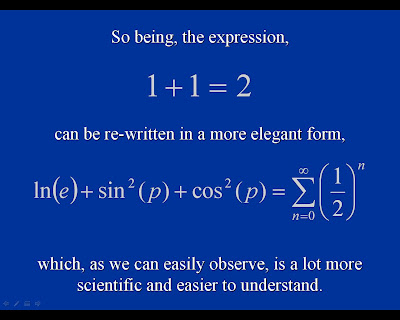There are about three people that are almost regular contributors to this blog and Marko Niemi is one of them. Marko has continued to keep me on my toes and has graciously sent me a link to a mathematical poem found on
vispoets.com 

I would like to dedicate this blog entry to Ed Schenk’s poem that he posted on
vispoets.com and I have reposted above.
First of all I would like to say I like Ed’s Pythagorean Theorem Poem with the idea of world being the hypotenuse of a triangle with the adjacent and opposite legs being perception and reality. Ed’s intent is such that he is asking whether the world is equal to these things. You notice that he has ‘???’ in the field of view. My guess is that Ed wanted to avoid the trap that too many people get hung up on concerning mathematical poetry. It seems that many people think that we are trying to create axioms or scientific statements. The latter idea I believe is due to the provenance of mathematics having much momentum since it is the language of science. However, I look at math poetry with a lack of scientific eyes. There could be an entire debate on whether Ed needed to put those question marks on his piece and I could argue both sides. The point I want to make is that mathematical poetry is not science.
I believe one good reason to leave the question marks on his poem are to insure that we avoid a philosophical debate and focus on the beauty of the language while entertaining the ideas presented. When it comes to philosophy and mathematical poetry I feel it is very difficult to be good at both philosophy and art. I feel mathematical poetry is less distractive when inspired by established philosophy and illuminated with a new and expanded life. Although I am sure that I have crossed the boundaries on occasion.
I love the form of Ed’s poem however; it is hard for me not to like a Pythagorean Theorem poem. I love everything about the Pythagorean Theorem for it is always a great one to ponder just because it has such a magical quality expressed in such simplicity. ---- Although, I wouldn’t advise it, one could spend their whole life making poems in this form alone.
Of course I will have to mention as soon as I see a mathematical poem in the form of the Pythagorean Theorem, like Ed’s, then my first thought is to take it into analytic geometry and map it on the Cartesian coordinate system.This in effect is taking the Pythagorean Theorem and spinning it around a single point to create the equation of a circle.

So what would Ed’s piece look like expressed on the Cartesian coordinate system? Well, let’s look at it. This is Ed's poem spun around a point with verbogeometric axes of perception and reality.

Another thing that always occurs to me when I look at the Pythagorean Theorem is to ask how many dimensions I need to express what I want. Ed has chosen two for his poem and this is good however, we have the option to pick as many as we want. Since the idea of ‘world’ could bring about a visualization of the earth we could choose three dimensions and use the equation of a sphere. (This is the equation of a circle spun around a line)
The image below is an example where I have added an extra dimension to Ed’s equation to come up with a spherical poem. I decided to use belief as a dimension because it was the first thing that popped into my head. For this paradigm, it is not important so much as to what I am saying for I am really just trying to serve an example of how to add an extra dimension to the equation for a circle to render the equation for a sphere. Thus creating a spherical poem or in other words the Pythagorean Theorem in three dimensions and visualized in the Cartesian coordinate system.
















 Another thing that always occurs to me when I look at the Pythagorean Theorem is to ask how many dimensions I need to express what I want. Ed has chosen two for his poem and this is good however, we have the option to pick as many as we want. Since the idea of ‘world’ could bring about a visualization of the earth we could choose three dimensions and use the equation of a sphere. (This is the equation of a circle spun around a line)
Another thing that always occurs to me when I look at the Pythagorean Theorem is to ask how many dimensions I need to express what I want. Ed has chosen two for his poem and this is good however, we have the option to pick as many as we want. Since the idea of ‘world’ could bring about a visualization of the earth we could choose three dimensions and use the equation of a sphere. (This is the equation of a circle spun around a line)




